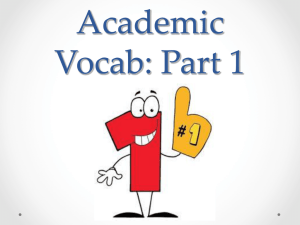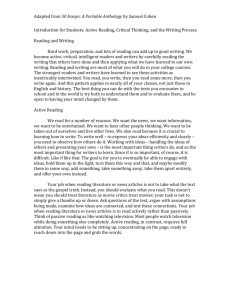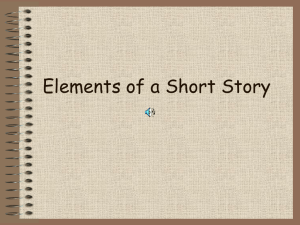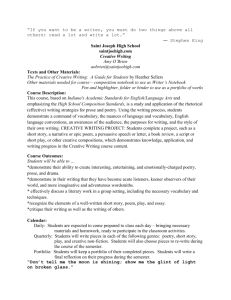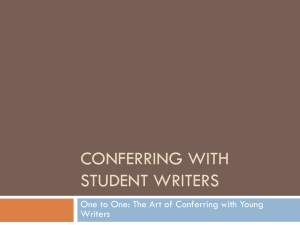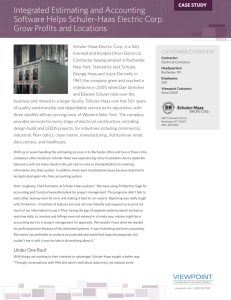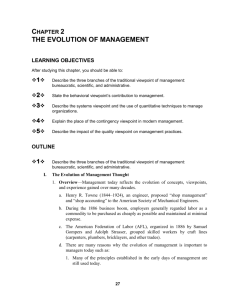Objective: In this lesson, you will learn how to write a short story
advertisement
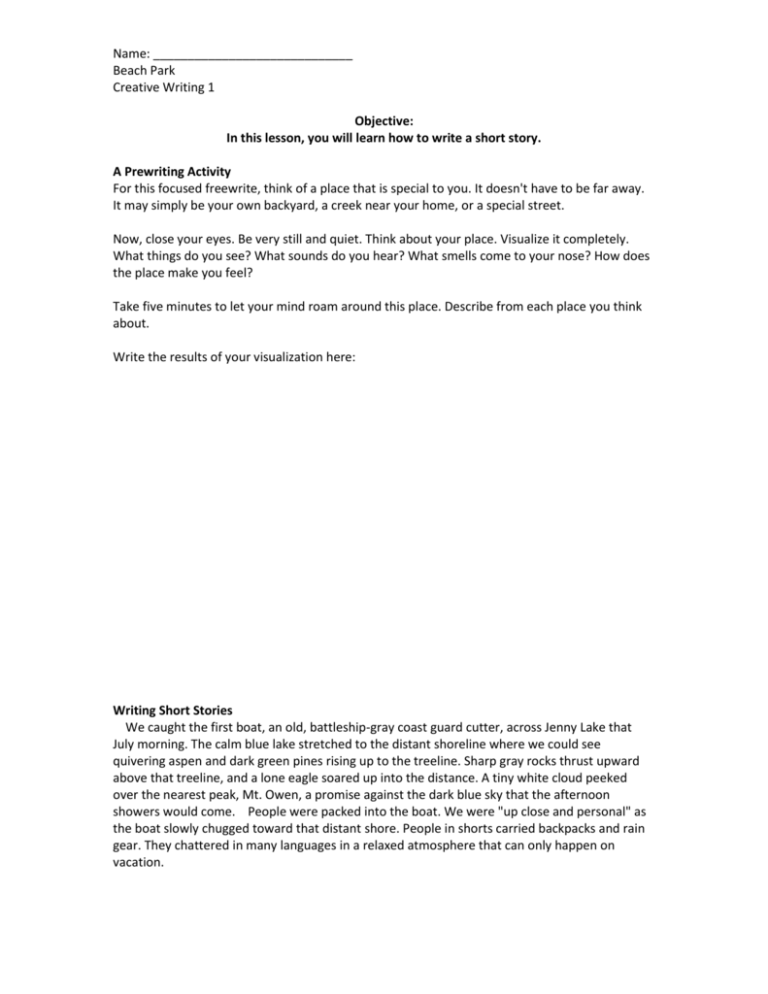
Name: _____________________________ Beach Park Creative Writing 1 Objective: In this lesson, you will learn how to write a short story. A Prewriting Activity For this focused freewrite, think of a place that is special to you. It doesn't have to be far away. It may simply be your own backyard, a creek near your home, or a special street. Now, close your eyes. Be very still and quiet. Think about your place. Visualize it completely. What things do you see? What sounds do you hear? What smells come to your nose? How does the place make you feel? Take five minutes to let your mind roam around this place. Describe from each place you think about. Write the results of your visualization here: Writing Short Stories We caught the first boat, an old, battleship-gray coast guard cutter, across Jenny Lake that July morning. The calm blue lake stretched to the distant shoreline where we could see quivering aspen and dark green pines rising up to the treeline. Sharp gray rocks thrust upward above that treeline, and a lone eagle soared up into the distance. A tiny white cloud peeked over the nearest peak, Mt. Owen, a promise against the dark blue sky that the afternoon showers would come. People were packed into the boat. We were "up close and personal" as the boat slowly chugged toward that distant shore. People in shorts carried backpacks and rain gear. They chattered in many languages in a relaxed atmosphere that can only happen on vacation. Name: _____________________________ Beach Park Creative Writing 1 We walked the plank from the boat to the shore and hiked the well-worn trail upward to Inspiration Point, a distance of some 2.5 miles. The climb begins as a gentle slope and then became steeper. As we moved upward in altitude, we began to shed layers of clothing and sip from the canteen we'd brought along. Writing a Story Here are the basic elements a writer puts into a story. Conflict Conflict is the problem that characters face in the story. There are 3 kinds of conflict. 1. Conflict between character and nature. (For example, two boys must learn to survive after being stranded on a deserted island.) 2. Conflict between two or more characters. 3. Internal conflict or conflict within the character. (For example, you are told not to eat sweets before dinner, but you want a piece of candy badly! Do you eat the candy or not? This is internal conflict.) Repetition Writers sometimes repeat things in a story. 1. Words are sometimes repeated. (Listen to people talk.) Writers will also repeat key words and phrases they don't want you, the reader, to miss. 2. Sometimes, events happen many times or a character will repeat an action. Setting Setting is where and when your story happens. Plot Plot is the sequence of events in a story. A plot has four parts: 1. A problem. The problem introduces conflict at the beginning of the story. 2. Obstacles. These keep the character from solving the problem too early in the story. 3. Climax. This is the action that occurs when the problem is about to be solved. 4. Resolution. This is also sometimes called the solution. The problem is solved and the roadblocks are overcome at the end of the story. Characters Characters in stories are developed in four ways. Name: _____________________________ Beach Park Creative Writing 1 1. Appearance: How characters look creates the first impression your reader gets of the characters. 2. Action: You've heard the saying, "Actions speak louder than words." This is true in stories. Your characters' actions should be typical of them. 3. Dialogue: This is a conversation between two or more characters. What characters say and how they say it reveals a lot about them. 4. Monologue: A character reveals his or her thoughts and feelings to the audience. Theme The theme is the underlying meaning of a story. The theme is sometimes stated clearly in the story and sometimes more subtly suggested by the characters. Point of View Writers tell a story according to one of four points of view: 1. First person viewpoint is when the writer uses "I" to tell the story through the eyes of one character. 2. Third person viewpoint is more objective. The writer reports the events as they happen. In this viewpoint you cannot know what characters are thinking. You can report only what they see and hear, and evaluate events based on this. 3. Omniscient viewpoint lets the writer see all and know all about each character. 4. Limited omniscient viewpoint lets the writer focus on one character and tells that character's thoughts and feelings. For your first story attempts, first person and third person viewpoints will probably be the best and easiest to use. An Assignment for Your Student Writing Portfolio: You are going to write a short story. Follow the instructions below. Remember to include a conflict, a theme, and all of the other parts of a short story we learned in this lesson. What is the title of your story? Begin writing here: Name: _____________________________ Beach Park Creative Writing 1 Story Beginning Write the beginning of your story. Introduce your characters, the setting and the conflict. Begin writing here: Story Middle Type the middle of your story. Write about the obstacles the characters face. Begin writing here: Story Ending Type the end of your story. Tell the climax and the resolution. Begin writing here:



